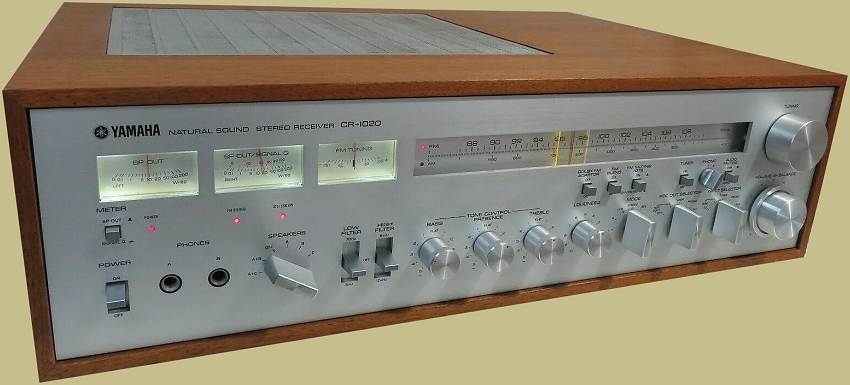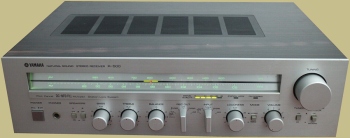
Manufactured in 1977, the Yamaha CR-1020 receiver was the younger brother of the Yamaha CR-3020 and CR-2020. It incorporated the trademark Yamaha styling with rectangular switches, linear layout, and white meter and dial faces. The CR-1020 puts out a hefty 70 watts per channel and has a rated total harmonic distortion of 0.1%. It retailed for around $540.

Front Panel
The CR-1020 has advanced design features borrowed from Yamaha’s high-end audio components such as the B-1 and B-2 power amps, C-1 control amp and CT-7000 tuner. The borrowed features include power meters, presence control, LED function indicators, and a signal quality meter. These give the receiver excellent sound quality, precise control, and useful visual feedback.
Non-Step Master Volume Control –
The receiver has a smooth, continuous volume control that maintains consistent left/right stereo balance at all levels. This avoids the abrupt volume jumps that can occur with other designs.
Continuously Variable Loudness Contour –
Unlike receivers with just an on/off loudness switch, the CR-1020 has a special loudness control that compensates for how our hearing changes at different volumes. This helps retain consistent tonal balance whether listening loudly or softly. This was also used in Yamaha’s C-1 control amp.
Completely Separate Recording and Listening –
You can listen to one audio source while recording another. For example, you can record FM radio while listening to a record, allowing flexible usage.
Comprehensive Tone and Filter Controls –
The bass, treble and special mid-range “presence” tone controls allow precise audio adjustment to suit room acoustics and personal taste. Separate high and low audio filters help eliminate unwanted noise such as tape hiss or turntable rumble.
Full Range Power Meters –
The CR-1020 has clear logarithmic power meters covering a wide decibel range to indicate both brief loud passages and sustained lower levels, for excellent visual monitoring.
The CR-1020 also has:
- Audio Muting,
- FM Muting
- FM Blend
- Provision for Three Sets of Speakers and Two Headphones
- LED Indicators of Major Receiver Functions
- Mode Switch (Stereo/Mono/L/R/Rev)

Optimum Tuning System
The FM Muting/OTS switch on the CR-1020 is a manual on/off switch for what Yamaha calls the Optimum Tuning System (OTS). This system works by automatically fine-tuning the exact position of radio stations to give the cleanest, least distorted sound with the best separation between left and right stereo channels.
So when you tune to an FM station on the CR-1020, even if your manual tuning is a bit off, the OTS will take over and precisely lock in the optimal tuning point for that station once you release the tuning knob. This ensures you always get peak reception quality no matter how accurately you tune manually.
The OTS switches off temporarily whenever you touch the tuning knob so regular manual tuning can be done easily. But then it kicks back in shortly after the knob is released to optimize the tuning.
The manual OTS on/off switch allows you to disable the auto-tuning if needed, like for example when listening to a weak station that you don’t want to be overpowered by the OTS trying to grab a stronger neighboring signal.

Tuner
The FM tuner on the CR-1020 is excellent. The AM tuner is not bad either. Here are some of the features:
Unique Four-Gang Tuning Capacitor –
The CR-1020 uses a specially designed tuning capacitor allowing for extremely accurate and stable FM/AM tuning performance. Combined with high-quality components like dual gate MOSFETs in the input stage, this gives exceptional tuning precision, interference rejection and wide dynamic range.
Negative Feedback Multiplex Section –
The stereo FM circuitry uses negative feedback (NFB) techniques to reduce distortion to extremely low levels. Along with phase-locked loop circuitry for solid tuning stability, this delivers outstanding FM stereo sound quality and contributes to the receiver’s overall ultra-low distortion.
Completely Effective Pilot Signal Cancellation –
The receiver cancels out the 19kHz stereo pilot signal that can cause interference, avoiding the crude filters other receivers use that can impair treble response. This preserves extended 18kHz high-frequency response for richer and clearer reproduction of high instruments and details.
Multi-Function FM/AM Signal Meter –
The tuning meter displays FM or AM signal strength and also indicates FM multipath interference to help optimize antenna orientation for the cleanest reception.
Superior AM Section –
The AM section uses some of the same high-quality circuitry as the FM, plus an equalizer. This gives dramatically improved AM sound virtually indistinguishable from FM, without needing a separate AM circuit design.

Amplifier
The CR-1020’s amplifier performs exceptionally well. It produces 70 watts per channel and achieves extremely low 0.05% distortion across the full 20Hz to 20kHz frequency range even when playing music at high volumes.
Here are some other features of the CR-1020 amplifier:
Excellent supply voltage rejection (SVR) for Negligible Dynamic Crosstalk –
The receiver’s improved power supply design prevents fluctuations that could cause faint sounds from one channel to be heard in the other channel during loud playback. This enhances stability and bass detail.
Logical Chassis Layout –
Careful component layout and shielding protects sensitive preamp circuits from power components. This achieves outstanding signal-to-noise ratio and silence between music.
Pre Out/Main In –
Unlike typical receivers, the CR-1020 has pre-out connections usable even during normal operation without having to disconnect plugs. This allows easy hookup to external gear like equalizers without signal interference.

Rear Panel

The rear panel includes:
- Antenna Inputs: 300 ohm balanced, 75 ohm unbalanced, coaxial.
- AM Ferrite Bar Antenna
- Phono 1 + 2
- Aux
- Tape 1 + 2 Playback + Record
- Dolby FM Adapter Input + output
- Pre-Out
- Main-In
- Coupler: On/Off

The CR-1020 has outputs for three sets of speakers but will only play one set or two sets at a time. There are 3 AC Outlets. One is switched and two are unswitched.

As a mid-range receiver in the Yamaha lineup the CR-1020 is an excellent choice if you don’t want to pay a premium price for the CR-2020 or CR-3020. It has complete functionality and top of the line performance in both the tuning section and amp section. Not to mention that iconic Yamaha look. You really can’t go wrong with a fully functioning CR-1020.


The CR-1020 that I have does not have any 110V accessory plugs on the rear panel. I see that they are mentioned in the above article. The CR-1020 I have is unmolested and still works great. Without the accessory plugs on the rear panel…..does that mean that I have possibly one of the earlier models of the 1020?
Thanks in advance for any information.
Regards,
John
US, Japanese models with 110/120 AC 60 have the switched AC outlets for turntables etc.
Australian, NZ etc models are 220/230 models.
I had a CR-1020 that fed a set of B&W DM2 Series II. Couldn’t fault it. It’s got plenty of grunt. Liked it a lot.
For that info I would consult audiokarma.org
Maybe a European model.
I bought some 10 inch R to R tapes from a gentleman. He just wanted to dump all his electronic equipment, which included three R to R units, and the Yamaha 1020, all for free. I took the 1020 down to the Hi Fi Workshop in Tucson. They went through it and, after a few minor repairs, it was in beautiful condition. Only missing a volume knob, which they replaced. It’s a fantastic receiver with a lot of guts. It’s in my guest room for their entertainment, but I slip in regularly just to listen myself. Got it connected to a pair of Mirage towers and a Polk Audio subwoofer. $180 for the repair was well worth it. Beautiful face and case and beautiful, clear and powerful sound. If you can get one for a reasonable price, then do it.